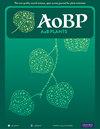A possible pattern in the evolution of male meiotic cytokinesis in angiosperms
IF 2.4
3区 生物学
Q2 ECOLOGY
引用次数: 0
Abstract
Evolution of cellular characteristics is a fundamental aspect of evolutionary biology, but knowledge about evolution at the cellular level is very limited. In particular, whether a certain intracellular characteristic evolved in angiosperms, and what significance of such evolution is to angiosperms, if it exists, are important and yet unanswered questions. We have found that bidirectional cytokinesis occurs or likely occurs in male meiosis in extant basal and near-basal angiosperm lineages, which differs from the unidirectional cytokinesis in male meiosis in monocots and eudicots. This pattern of cytokinesis in angiosperms seems to align with the distribution pattern of angiosperms with the lineages basal to monocots and eudicots living in tropical, subtropical, or temperate environments and monocots and eudicots in an expanded range of environments including tropical, subtropical, temperate, subarctic and arctic environments. These two cytokinetic modes seem to result from two phragmoplast types, respectively. A phragmoplast in the bidirectional cytokinesis dynamically associate with the leading edge of a growing cell plate whereas a phragmoplast in the unidirectional cytokinesis is localized to an entire division plane. The large assembly of microtubules in the phragmoplast in unidirectional cytokinesis may be indicative of increased microtubule stability compared with that of the small microtubule assembly in the phragmoplast in bidirectional cytokinesis. Microtubules could conceivably increase their stability from evolutionary changes in tubulins and/or microtubule-associated proteins. Microtubules are very sensitive to low temperatures, which should be a reason for plants to be sensitive to low temperatures. If monocots and eudicots have more stable microtubules than other angiosperms, they will be expected to deal with low temperatures better than other angiosperms. Future investigations into the male meiotic cytokinetic directions, microtubule stability at low temperatures, and proteins affecting microtubule stability in more species may shed light on how plants evolved to inhabit cold environments.被子植物雄性减数分裂细胞分裂进化的可能模式
细胞特征的进化是进化生物学的一个基本方面,但有关细胞水平进化的知识却非常有限。特别是,某种细胞内特征是否在被子植物中进化,如果存在,这种进化对被子植物有什么意义,这些都是尚未解答的重要问题。我们发现,在现存的基生和近基生被子植物系中,雄性减数分裂过程中存在或可能存在双向细胞分裂,这不同于单子叶植物和真叶植物雄性减数分裂过程中的单向细胞分裂。被子植物的这种细胞分裂模式似乎与被子植物的分布模式一致,即单子叶植物和裸子植物的基干品系生活在热带、亚热带或温带环境中,而单子叶植物和裸子植物则生活在热带、亚热带、温带、亚北极和北极等更广阔的环境中。这两种细胞运动模式似乎分别来自两种噬菌体类型。双向细胞运动中的噬菌体与生长细胞板的前缘动态结合,而单向细胞运动中的噬菌体则定位在整个分裂平面上。与双向细胞运动中膈膜上的小微管集结相比,单向细胞运动中膈膜上的大微管集结可能表明微管的稳定性增强了。可以想象,微管蛋白和/或微管相关蛋白的进化变化会增加微管的稳定性。微管对低温非常敏感,这应该是植物对低温敏感的一个原因。如果单子叶植物和真叶植物的微管比其他被子植物更稳定,那么它们就会比其他被子植物更好地应对低温。未来对更多物种的雄性减数分裂细胞运动方向、低温下的微管稳定性以及影响微管稳定性的蛋白质的研究可能会揭示植物是如何进化以适应寒冷环境的。
本文章由计算机程序翻译,如有差异,请以英文原文为准。
求助全文
约1分钟内获得全文
求助全文
来源期刊

AoB Plants
PLANT SCIENCES-
CiteScore
4.80
自引率
0.00%
发文量
54
审稿时长
20 weeks
期刊介绍:
AoB PLANTS is an open-access, online journal that has been publishing peer-reviewed articles since 2010, with an emphasis on all aspects of environmental and evolutionary plant biology. Published by Oxford University Press, this journal is dedicated to rapid publication of research articles, reviews, commentaries and short communications. The taxonomic scope of the journal spans the full gamut of vascular and non-vascular plants, as well as other taxa that impact these organisms. AoB PLANTS provides a fast-track pathway for publishing high-quality research in an open-access environment, where papers are available online to anyone, anywhere free of charge.
 求助内容:
求助内容: 应助结果提醒方式:
应助结果提醒方式:


